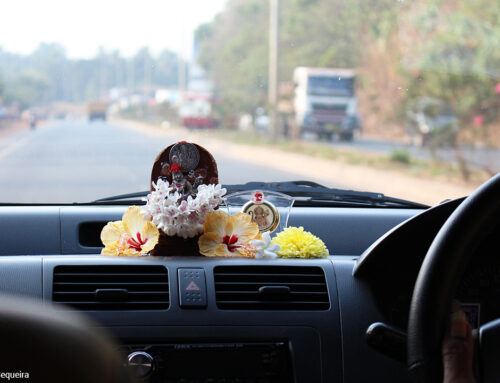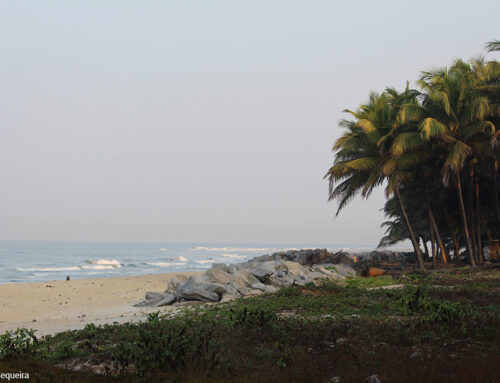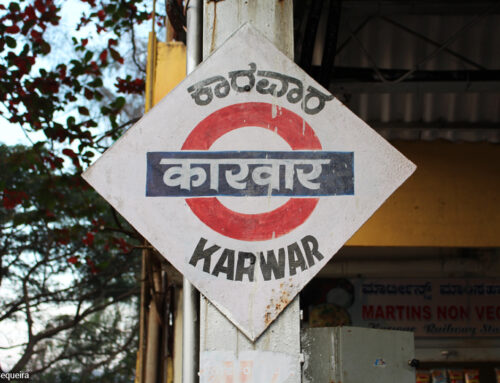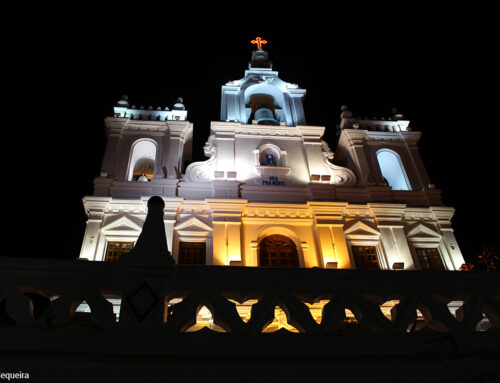Few Goans know the history of the Catholic community of Mangalore. And fewer care to acknowledge the historical fact that the forefathers (and mothers) of today’s Mangaloreans packed their belongings, bhason (pots), bhimla (souring agent) et al and travelled further south down the Konkan coast, to jealously guard and preserve the customs and culture of yore. Many Goans decided to up and leave before these important customs and mores were systematically decimated by our colonial cousins, the Portuguese. This historical happenstance had always fascinated me. Add to this, the never-ending ‘who’s sorpotel is better’ quarrel one encounters at many parties where Goans and Mangaloreans mingle but rarely mix. And, of course, my professional partnership with Alan over 30 years. So Mangalore was always high on my list of ‘must visit’ places in India. I simply had to visit this place where the community clung to Catholicism and culture, despite facing violence and innumerable hardships.
I was so excited to see this place of enterprising folks – many of whom have been close friends – that I didn’t mind hopping on a public bus in Udupi for the 1 hour ride to Mangalore. The topography looked familiar – so much like my Goa. Verdant fields, gushing rivers, swaying coconut palms, hawkers shouting themselves hoarse, buses driving dangerously close to every vehicle that dares to overtake them, green hills laden with cashew and mango flowers… pure déjà vu.
Alan and I took a detour to Bondel to meet with Walter Nandalike and Dayan D’Souza, who happened to be in town at that time. They are the founders of Daiji World and Daiji TV – the brilliantly conceptualized portal and TV channel that provide information on all things Mangalore, and Konkani. Mangalore folks have always shown great respect and love for the Konkani language. Daiji TV is testament to this, broadcasting many programs in Konkani and giving a platform to Konkani singers, actors and presenters. The studios are impressive and the hard work of the founding members is evident everywhere. Ivan Sequeira, the famous Mangalorean Konkani singer with the melodious voice, came by to visit us while we were there – a humble man, despite his huge talent. I must also make a mention that later that week Daiji world felicitated Alan and I for starting and running the Konkani radio show – Radio Mango in Toronto for 6 years (the first of it’s kind in the entire Northern Hemisphere) at a special function in Udupi where they felicitated many other Konkani artistes. Thank you Daiji World for acknowledging our contribution to our beloved Konkani.
After that we headed back towards Mangalore city. Soon it was time for the highlight of the day – lunch. Alan had been dreaming of a place where his father used to take him as a child for a special treat – Pereira’s Restaurant in Hampankatta, the heart of Mangalore city. As Alan was familiar with this place, I gave him the menu, telling him to surprise me. He quickly ordered Pork Bafat, Pork Roast, Fish Masala Fry and Parathas plus complimentary rice. Alan loves his pork and pigs out on it every time he gets the chance! The Kingfish was generously coated in thick red masala and fried to perfection. But the taste that has lingered on my tongue even today is that of the succulent Pork Bafat. For the uninitiated, Bafat or Bafad (as it is known in Goa) is a mixture of spice powders that contributes to a tasty yet fiery creole dish that combines the aromas of Portugal and India. Some say the word is derived from the Portuguese word ‘abafar’- to stifle – and certainly the Bafat masala could easily choke any unsuspecting firang!
Pereira’s Restaurant was started in 1921 by Mr. Ignatius Pereira with the intention of serving simple home style meals of fish fry, a vegetable dish and rice & curry at a very nominal price for the common folk, which stays true even to this day. It has also evolved and expanded over the years, but they have not sacrificed the authenticity and taste of their dishes. Their melt-in-your-mouth Pork Bafat was so unbelievably delicious, Alan and I both looked up and said in unison: “We’ve found our perfect curry!”. Remember, we had started Chasing the Perfect Curry in Ratnagiri. And here, in a non-descript restaurant, run by a third generation Pereira, we found a curry where the attention was solely on flavour and spice. The Bafat was perfect in every way: The flavour, spices and texture had all come together for an astoundingly tasty Bafat. Mr. Pereira, who was presiding at the counter with his daughter by his side, beamed with joy when we told him how much we’d enjoyed his scrumptious Pork Bafat. He then gave us a tour of his kitchen, which resembled a home kitchen, except that the pots and pans were humungous, as were the wood burning stoves on which they simmered and bubbled all day. Alan was astounded that nothing had changed for over 40 years that he had known this place! Especially, the taste of the authentic Mangalorean cuisine, which had captured our taste buds at the very first spoonful! Check out for the Bafat Powder and Mangalorean Pork Bafat recipes in our Recipe Section.
It was a real effort to take our filled-to-the-top tummies to the next stop on our itinerary: St Aloysius Chapel and College. It is the alma mater of many people I knew in Canada and so I wanted to pay this historic education institute a visit. Notable alumni from this great institution includes the politician George Fernandes and the writer Arvind Adiga of White Tiger fame. Built in 1880, the structure stands in solid testimony to the contribution it has made to education in Mangalore, proudly displaying the motto: ‘Lucet et Ardet” – latin for “Shine to Enkindle’. At that time of day, it was very quiet, its 37 acre campus offering a peaceful ambience.
Then, it was time for the last highlight, for which Alan had waited with bated breath all day: The snack store, Komal’s Sweet Palace. This was a veritable Konkan cornucopia! Every savoury and sweet snack that one could think of was here, waiting for those of us who love to indulge our nostalgic taste buds. Alan and I had a fun time choosing Chaklis, Laddoos, Halwas, Mysore Pak, Cookies and more. So much to tempt us, but such little space in our suitcase. But Alan was not to be deterred. He took every snack – savoury and sweet – that had filled his childhood with joy and was now packed with nostalgia.
Our bus ride back to Udupi was uneventful. But we had enough on our minds; we had found the perfect curry, at last! For a while, we were worried that we were almost at the end of our journey, but hadn’t come across a curry that had made both of us sit up! But, there was still Kasargod left on our itinerary, the last stop of our Konkan Odyssey. What would we discover there? We will tell all in the next and final chapter of our epic and memorable Konkan coast journey. Stay tuned.
For photographs go to the Photo Gallery tab above; likewise for recipes.
Things to do in Mangalore:
Surfing:
• Mantra Surf Club
Beaches:
• Panambur
• Tannirbhavi
• Chitrapura
• Surathkal
• Kodical
• Someshwara
• Ullal
• Sasihithlu
Parks:
• Kadri Hills
• Sammilan Shetty’s Butterfly Park
• Tannirbhavi Tree Park
• Light House Hill Garden
• Pilikula Nisarga Dhama
Churches:
• Milagres
• St. Aloysius Chapel
• Our Lady of Rosary Cathedral
Temples:
• Mangala Devi
• Kudroli Gokarnath
Forts:
• Sultan Bateri
• Jamalabad
• Bekal
Education:
• National Institute of Technology – Surathkal
• Father Muller Medical College
• St Aloysius College
Best time to visit: November – March
Know your Konkan Coast

The Konkan coast runs south from Mumbai all the way to Kasargod. Quaint fishing villages and magnificent forts look out into the endless blue of the Arabian sea. Pristine beaches and coconut palm trees dot the coast all along, until you reach Malvan, the last beach town of significance, before the sands dissolve into Goa. The cuisine along the Konkan coast is as varied as it is delicious, greatly influenced by its geographic location, and layered history of the region. They are all intertwined yet distinct. Some patterns are common – like the seasons which influenced bottling pickles, and drying of fish and pork etc. The monsoon brought a lot of seasonal foods like bamboo, snails (conge) etc to the table. Coconut is an integral part of the Konkan cuisine. Apart from local influences, Portuguese and Arab influences had major impacts.








